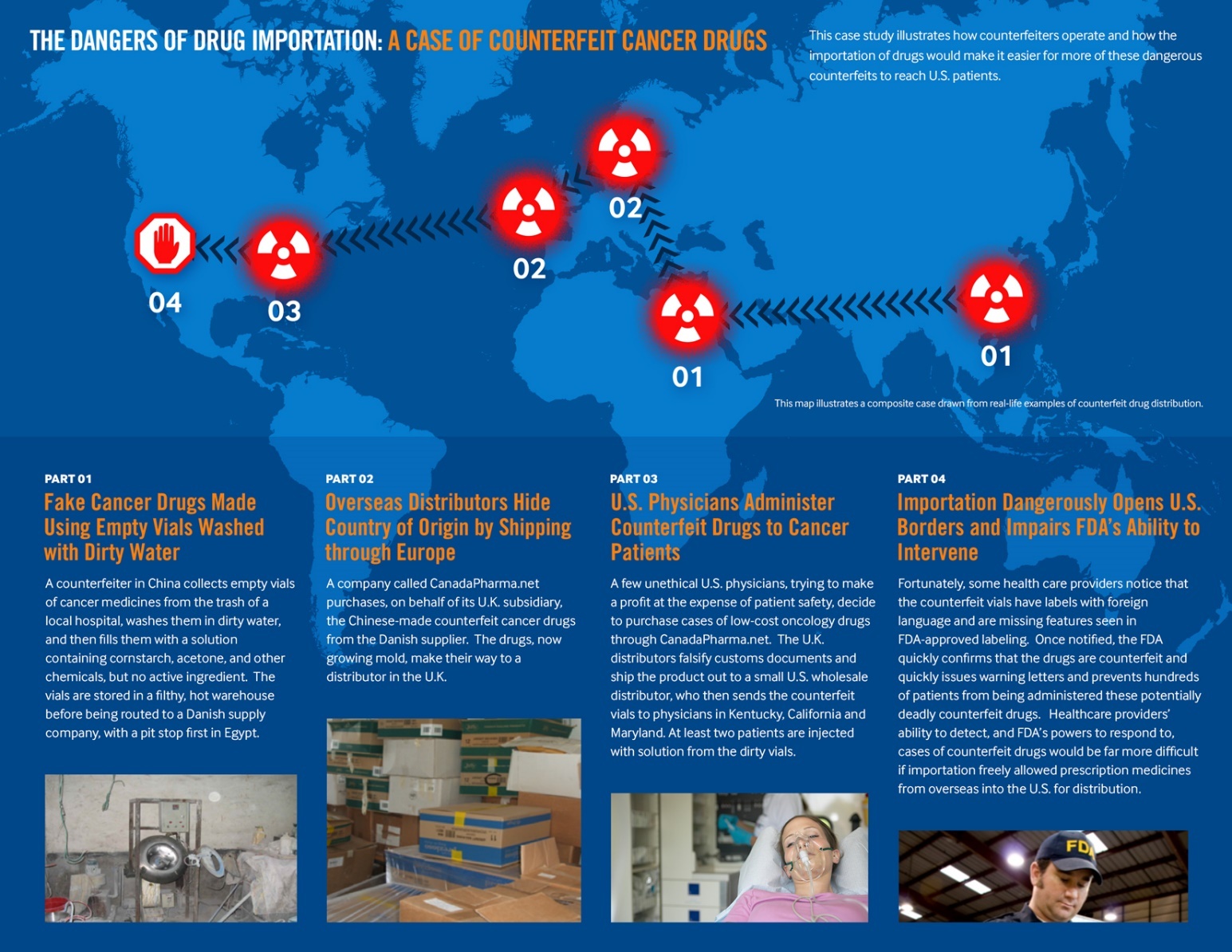Counterfeit drug trafficking is a multibillion dollar business that threatens the health and well-being of patients. The World Health Organization estimates 10 percent of medicines worldwide are counterfeit, including up to half of the drugs consumed in developing nations. Fortunately for Americans, the United States operates the safest prescription drug supply chain in the world. The U.S. Food and Drug Administration (FDA) oversees the most comprehensive drug approval and regulatory process, and the tightly operated distribution system helps prevent the entry and spread of counterfeit, adulterated or substandard medicines into the United States. The importation of unapproved medicines would undermine all of this.
Proponents often claim that the importation of medicines is a way to reduce the cost of medicines in the United States. However, this is the wrong answer. The FDA regulates virtually every stage of a prescription drug as it moves through the U.S. supply chain. Legalizing the importation of unapproved medicines would open up the U.S. prescription drug supply to unapproved foreign drugs, creating multiple avenues for unscrupulous counterfeiters to enter the U.S. market, threatening patient well-being. In fact, the FDA has stated it cannot make safety or quality determinations of medicines imported from foreign countries and that the risks of unapproved drugs outweigh any potential cost savings. The Congressional Budget Office estimates a mere one percent reduction in drug spending under importation, and there is no guarantee payers would see any of the potential savings.
In the case of cancer treatments, the pathway to develop counterfeit drugs is an all too alarming reality. A new case study illustrates the pathway counterfeiters may exploit to move their fake medicines from their unhygienic factories, around the globe and into the United States.
Part 1: Fake Cancer Drugs Made Using Empty Vials Washed with Dirty Water
It is becoming increasingly easy for counterfeiters to make fake and dangerous products that look like genuine medicines. In China, a counterfeiter was able to collect empty vials of a cancer medication from a hospital’s trash and refill them with a solution of water and an assortment of chemicals. The counterfeiter then shipped the vials containing the dirty fluid through the Middle East or North Africa before selling to a European supply company.
Part 2: Overseas Distributors Hide Country of Origin by Shipping Through Europe
Once in the hands of the Danish supplier, an online Canadian retailer purchased the fake cancer treatments made by the Chinese counterfeiter and shipped the vials through its U.K. distributor to U.S. drop shippers in several states. The U.K. distributor falsified customs declarations in order to ship the illegal counterfeit drugs into the United States.
Part 3: U.S. Physicians Administer Counterfeit Drugs to Cancer Patients
In an effort to make more money, several U.S. physicians purchased low-cost oncology drugs from the online Canadian retailer, jeopardizing patient safety by treating cancer patients with the counterfeit stock. At least two patients are believed to have been treated with the fake drug. Patients who received the phony medication “could have lost several months of their lives,” according to a New York oncologist.
Part 4: Importation Dangerously Opens U.S. Borders and Impairs FDA’s Ability to Intervene
Upon notification from diligent health care providers, the FDA confirmed the existence of the counterfeit drugs in the United States and issued over 100 letters to physicians warning them of the contaminated products. If importation of drugs from foreign countries were allowed, the discovery and elimination of counterfeit drugs in the U.S. pharmaceutical supply would be far more difficult.
It is critical for patients to know that foreign governments cannot ensure the safety and efficacy of medicines entering the U.S. system. In 2014, drug regulators in China found that 75 percent of foreign cancer medicines purchased online were counterfeit or ineffective. Last year, the FDA and Interpol seized illegal medicines and medical devices from “more than 1,050 websites.”
The U.S. marketplace for prescription medicines, regulated by the FDA, provides the most secure means of medication delivery for all patients. A rampant counterfeit drug trafficking business and lack of security of foreign-purchased drugs should override any promise of potential meager savings. The safety and well-being of patients must always be a top priority of the health care system.





